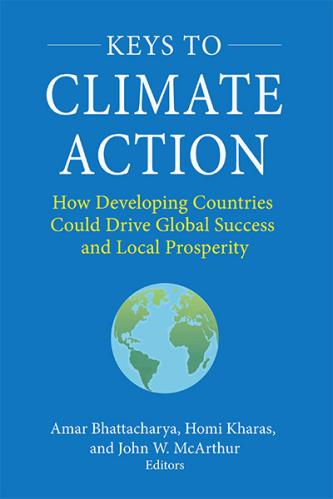Judging by his public pronouncements, Prime Minister Manmohan Singh had set two distinct goals for himself when deciding his strategy for Copenhagen negotiations. First, he wanted to leave no room for the western media and politicians to paint India as obstructionist as had repeatedly happened during the as Doha negotiations. Second, being firmly of the view that in the long run India will suffer disproportionately more from catastrophes resulting form global warming, he wanted to cut a deal that would lead to major reductions in carbon emissions worldwide.
To avoid any impression that India was less than serious in its efforts to reach an agreement, Singh went so far as to state in his maiden speech in Copenhagen that India will deliver on its promise of bringing down its 2005 emission intensity by 20 percent by 2020 even if an agreement were not reached in Copenhagen. In the end, he was successful in impressing upon President Barrack Obama that India had offered to do more than what a poor, vulnerable country could afford. Obama applauded India for voluntarily committing to “very significant mitigation” effort. Reminding his audience at Copenhagen that India has hundreds of millions of people living in abject poverty and without electricity, Obama stated in his speech, “For them, even voluntarily to say, we are going to reduce carbon emissions relative to our current ways of doing business by X percent is an important step. And we applaud them for that.” Singh had scored a decisive public relations victory—after this endorsement by Obama, no newspaper or TV commentator would dare point a finger at India as the obstruction to an agreement.
Singh’s success in scoring a diplomatic victory was matched by his failure in achieving a deal that would credibly arrest global warming, however. He had staked much on being able to persuade the United States to agree to an ambitious agreement in Copehagen, committing India to ever-higher levels of mitigation on a voluntary basis. From his initial position that given the country’s low per-capita emissions, India should not be subjected to any mitigation commitments, Singh went on step-by-step to raise the level of his country’s voluntary commitments. First came his promise not to let per-capita emissions of India ever to exceed the average of per-capita emissions of industrial countries. Then, he proceeded to commit to the goal of holding the average temperature increases around the globe to 2°C. This was followed by the announcement of eight national missions aimed at mitigation, which included plans to introduce building codes, tighter auto emission standards, increase in the share of green sources of energy to 20 percent by 2020 and even a cap and trade program for selected sectors. Finally, in the last week prior to the beginning of the Copenhagen summit, he committed India to cutting 2005 emission intensity by 20 percent by 2020.
As a part of as yet non-binding Copenhagen Accord, Singh also accepted the U.S. demand for submission of mitigation plans to the United Nations Framework Convention on Climate Change. Additionally, India will submit a progress report on mitigation every two years that will be subject to “international consultations and analysis under clearly defined guidelines.” In principle, this provision can be seen as a first step towards the conversion of what are currently “voluntary” steps towards mitigation into internationally mandated commitment that Singh and his environment minister have promised not to accept under any circumstances.
These progressively rising levels of concessions have not led to any improvement in the offer by the United States, which currently stands at cutting it’s the country’s 1990 emissions by merely 3 percent by 2020. This commitment compares rather unfavorably with the commitment to cut 1990 emissions by 7 percent by 2012 under the 1997 Kyoto Protocol that the United States had signed but refused to ratify. One may argue that the United States has put on the table financing for adaptation and mitigation by the developing countries as a part of the Copenhagen Accord. But the proposed level of funding at $30 billion in the first three years, which must be spread over more than 150 countries, is tiny. More importantly, much of this funding is likely to go to the least developed and island countries. It is unlikely India will reap any benefit from this fund.
This meager U.S. response testifies to Singh’s failure to achieve his second objective. Unless Singh is able to persuade the United States (and other industrial countries) to undertake far more ambitious cuts in emissions under a final agreement that is to succeed the Copenhagen Accord, his own commitments on behalf of India could prove costly to his country. On one hand, he will not have achieved the goal of avoiding environmental catastrophes and on the other, he would have ended up compromising growth and poverty alleviation. Under existing technologies, cuts in emissions or their growth are almost sure to translate into cuts in energy consumption or its growth, which would in turn adversely impact India’s GDP growth and poverty alleviation.
It may be recalled that India is a poor but rapidly growing economy. Its ability to withstand natural disasters in the next two to three decades depends crucially on its ability to sustain and accelerate its current growth rate of 8 to 9 percent. Such growth would allow the citizens to access shelters that can withstand cold, heat and rain and impart them with the means of rapid transportation and communications. The income increases will also place more resources in the hands of the government to build bridges, roads and dikes to help deal with natural disasters more effectively. In so far as mitigation commitments compromise growth, they will undermine the ability of Indians to withstand natural disasters that would occur in the next two to three decades regardless of emission levels around the globe.
Prime Minister Singh will need to carefully weigh this cost of India’s own mitigation commitments against the benefits to be reaped from improved commitment offers from industrial countries in the negotiations for a final climate accord. He must remember that given just 4 percent share in global emissions, mitigation by India by itself has virtually no impact on future global warming. His commitments will acquire value only if major emitters countries sign on to an ambitious mitigation agreement.



Commentary
Op-edThe Copenhagen Accord and India
December 21, 2009